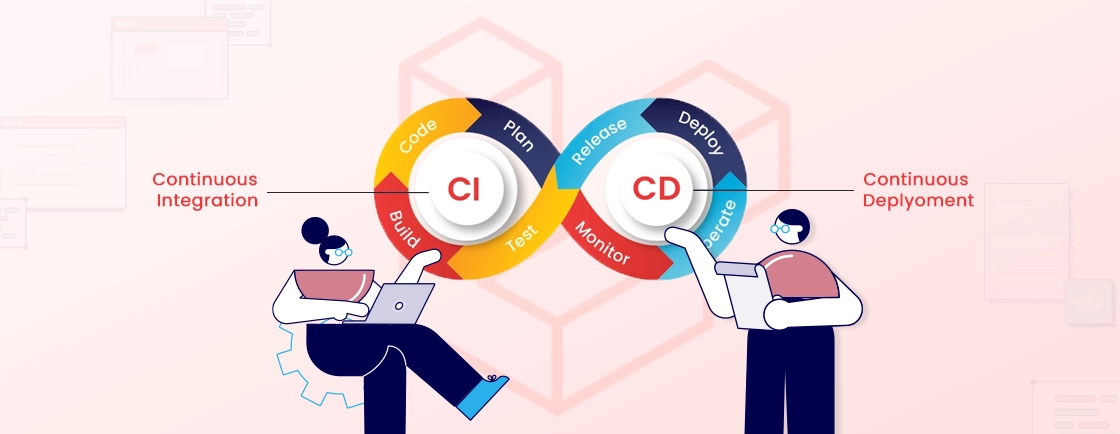Quick Summary
This blog explains how Laravel and Docker work together to simplify web development and deployment. It covers what each technology does, why combining them enhances scalability and efficiency, and how to set up Laravel with Docker for both development and production. Together, they ensure consistent environments and streamlined application delivery.
Table of Contents
One of the reasons Laravel has emerged as one of the best PHP frameworks is that it simplifies complex tasks and promotes best practices. So the developers can focus on creating innovative solutions rather than grappling with mundane coding challenges.
And the need for efficient deployment and scalability has given rise to containerization technologies. Docker, a leading player in this domain, provides a standardized way to package and deploy applications, making them portable across various environments.
Now, combining the strengths of Laravel and Docker has become a prevalent approach, revolutionizing the development process and offering a myriad of benefits to developers and businesses alike. Let’s dive into the symbiotic relationship between Laravel and Docker, exploring the advantages and insights that come with this powerful duo. So we begin.
What is Laravel?
Laravel stands tall as a PHP web application framework renowned for its elegance and efficiency in crafting robust and scalable applications. Developed by Taylor Otwell, Laravel has swiftly become a favorite among developers, thanks to its expressive syntax and comprehensive feature set.
- Eloquent ORM: Laravel’s Eloquent ORM simplifies database interactions by providing an intuitive syntax, enabling developers to work with databases using elegant and expressive code. This makes database management seamless and developer-friendly.
- Blade Templating Engine: Laravel employs the Blade templating engine, offering a lightweight yet powerful tool for designing views in the application. It promotes code reusability and allows developers to create dynamic, engaging user interfaces effortlessly.
- Artisan Console: Laravel ships with Artisan, a powerful command-line tool that automates various development tasks. From database migrations to code generation, Artisan boosts productivity by streamlining routine processes, fostering an efficient development environment.
- Middleware for HTTP Requests: Laravel’s middleware system enables developers to filter HTTP requests entering the application. This provides a flexible mechanism for adding functionalities to the HTTP pipeline, enhancing control over the request-handling process.
- Laravel Mix: Simplifying asset compilation and management, Laravel Mix brings together the best features of popular build tools. With an elegant API and robust configuration options, it empowers developers to effortlessly manage and optimize frontend assets.
Laravel combines a rich feature set with a developer-friendly environment, making it an ideal choice for building modern, scalable web applications. Its commitment to simplicity and elegance resonates throughout the development process, ensuring developers can focus on crafting exceptional user experiences.
What is Docker?
Docker, a revolutionary containerization platform, has reshaped the landscape of software development and deployment. Born out of the necessity for consistency across various environments, Docker provides a standardized approach to packaging, shipping, and running applications, encapsulated within lightweight, portable containers.
- Containerization Technology: Docker utilizes containerization, enabling developers to package an application and its dependencies into a single unit, the container. These containers are isolated, ensuring consistent performance across diverse environments, from development to production.
- Docker Images: Docker images serve as blueprints for containers, containing everything needed to run an application—code, libraries, and dependencies. This ensures that applications run consistently, irrespective of the underlying infrastructure, streamlining the deployment process.
- Docker Compose: Simplifying multi-container application management, Docker Compose allows developers to define and manage application services in a declarative manner. It facilitates orchestration, enabling the seamless coordination of various containers to run complex applications.
- Portability and Scalability: Docker’s containerized approach enhances portability, allowing applications to run seamlessly across different environments. Additionally, the lightweight nature of containers promotes scalability, enabling efficient resource utilization and deployment of applications at scale.
- Docker Hub and Registries: Docker Hub acts as a centralized repository for sharing and accessing container images. Developers can leverage Docker registries to store and distribute images, fostering collaboration and efficiency in managing containerized applications.
Docker has become synonymous with streamlined, consistent, and efficient software deployment. Its containerization technology empowers developers to build, ship, and run applications with unprecedented flexibility, fostering a new era of agility and reliability in the world of software development.
Why Use Laravel and Docker Together?
Combining the strengths of Laravel and Docker represents a dynamic synergy that significantly enhances the web development process. Laravel’s elegance and efficiency find a natural complement in Docker’s containerization, creating a powerful duo that streamlines development workflows and facilitates seamless deployment.
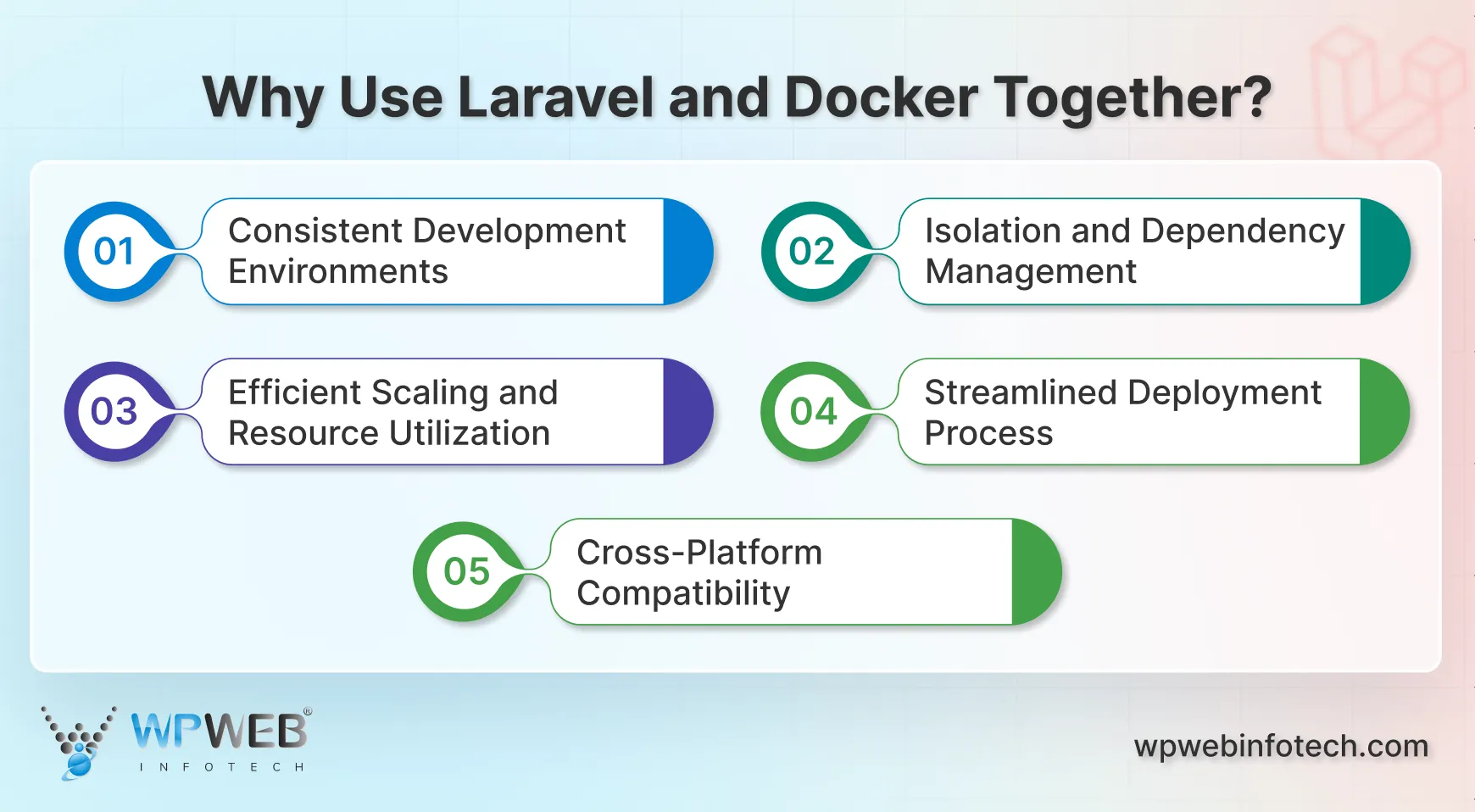
- Consistent Development Environments: Docker ensures consistent development environments across teams, eliminating the infamous “it works on my machine” issue. Developers can easily share Dockerized Laravel environments, reducing setup time and enhancing collaboration.
- Isolation and Dependency Management: Docker containers encapsulate Laravel applications and their dependencies. This isolation prevents conflicts between different projects, making it easier to manage dependencies, libraries, and configurations without impacting other applications.
- Efficient Scaling and Resource Utilization: Docker’s lightweight containers facilitate efficient resource utilization, allowing Laravel applications to scale effortlessly. Developers can deploy and scale Laravel applications consistently, ensuring optimal performance and responsiveness.
- Streamlined Deployment Process: Docker simplifies the deployment process by packaging the Laravel application along with its dependencies into a single container. This container can be easily moved between development, testing, and production environments, streamlining the deployment pipeline. For developers preferring managed deployments, Laravel Forge offers an excellent way to automate and simplify server setup.
- Cross-Platform Compatibility: Laravel and Docker together provide cross-platform compatibility, allowing developers to build and run applications seamlessly across different operating systems. This flexibility is invaluable for teams working in diverse environments and using various tools.
The integration of Laravel and Docker streamlines the development lifecycle, fostering collaboration, scalability, and consistency. This powerful combination empowers developers to build and deploy Laravel applications with confidence, knowing that they can efficiently manage dependencies, scale applications, and deliver consistent experiences across diverse environments.
To maximize the benefits of Laravel Docker integration, consider consulting our team for expert Laravel development services.
How to Set up Laravel With Docker?
Setting up Laravel with Docker empowers developers to create a consistent and isolated environment for their applications, streamlining the development process. Docker’s containerization ensures that the Laravel application runs consistently across different environments, reducing compatibility issues and simplifying deployment. Here’s a step-by-step guide to help you seamlessly integrate Laravel with Docker.
1. Install Docker
Before embarking on the journey of Dockerizing your Laravel application, the initial step is to install Docker on your development machine. Docker provides a unified platform for developing, shipping, and running applications, offering a standardized environment across various systems.
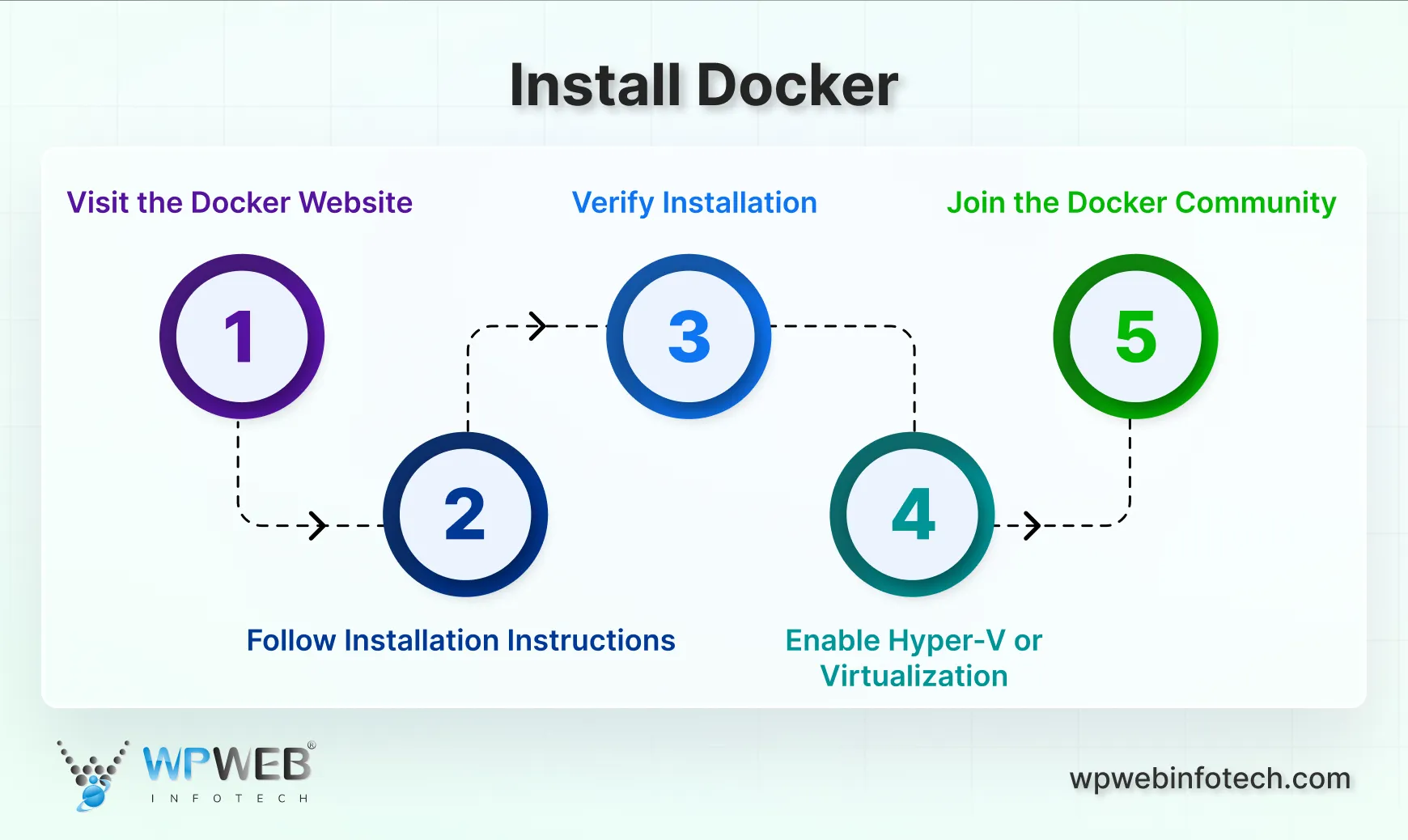
- Visit the Docker Website: Head to the official Docker website to download the Docker Desktop application. Docker provides tailored installers for Windows, macOS, and Linux, ensuring a straightforward installation process.
- Follow Installation Instructions: Execute the downloaded installer and follow the on-screen instructions. The installation typically involves accepting license agreements, configuring preferences, and initiating the Docker Desktop application.
- Verify Installation: After installation, verify Docker’s successful setup by running simple commands in your terminal or command prompt. Confirm that Docker is up and running, indicating a successful installation.
- Enable Hyper-V or Virtualization: On Windows systems, ensure that Hyper-V or virtualization is enabled in the BIOS settings. Docker relies on these features for creating lightweight containers, and enabling them is crucial for optimal performance.
- Join the Docker Community: Explore the vibrant Docker community to stay updated on best practices, troubleshooting tips, and new features. Engaging with the community provides valuable insights and support for your Dockerized Laravel journey.
With Docker successfully installed on your machine, you’ve laid the foundation for a containerized Laravel environment. This pivotal first step ensures that your Laravel application can leverage the benefits of Docker’s containerization technology, promoting consistency and efficiency throughout the development lifecycle.
2. Create a Laravel Project
Now that Docker is seamlessly integrated into your development environment, the next step is to initiate a new Laravel project. Laravel, with its expressive syntax and powerful features, lays the groundwork for a robust web application, and creating a project is a straightforward process.
- Open a Terminal or Command Prompt: Navigate to the directory where you wish to create your Laravel project using the terminal or command prompt. This directory will house the files and folders of your Laravel application.
- Use Composer to Create a Project: Execute the command ‘composer create-project –prefer-dist laravel/laravel project-name in the terminal. This Composer command downloads the latest Laravel release and sets up a new project with the specified name.
- Wait for Dependencies to Install: Composer will download Laravel and its dependencies. This process may take some time depending on your internet connection. Once completed, you’ll have a fresh Laravel project ready for development.
- Navigate into the Project Directory: Change your working directory to the newly created Laravel project using the ‘cd project-name’ command. This step is crucial as subsequent Docker configurations will be applied within this project directory.
- Verify Laravel Installation: Run the Laravel development server by executing the ‘php artisan serve’ command. Visit ‘http://localhost:8000’ in your web browser; if you see the Laravel welcome page, your Laravel project is successfully set up.
With your Laravel project established, you’ve laid the groundwork for building your web application. The seamless integration of Laravel and Docker will now amplify the development experience as you proceed to containerize and enhance your project with the benefits of Docker’s containerization.
3. Dockerize the Laravel Project
With your Laravel project in place, the next pivotal step is to dockerize it—encapsulating the application and its dependencies within a Docker container. This containerization ensures consistency in development and facilitates seamless deployment across various environments.
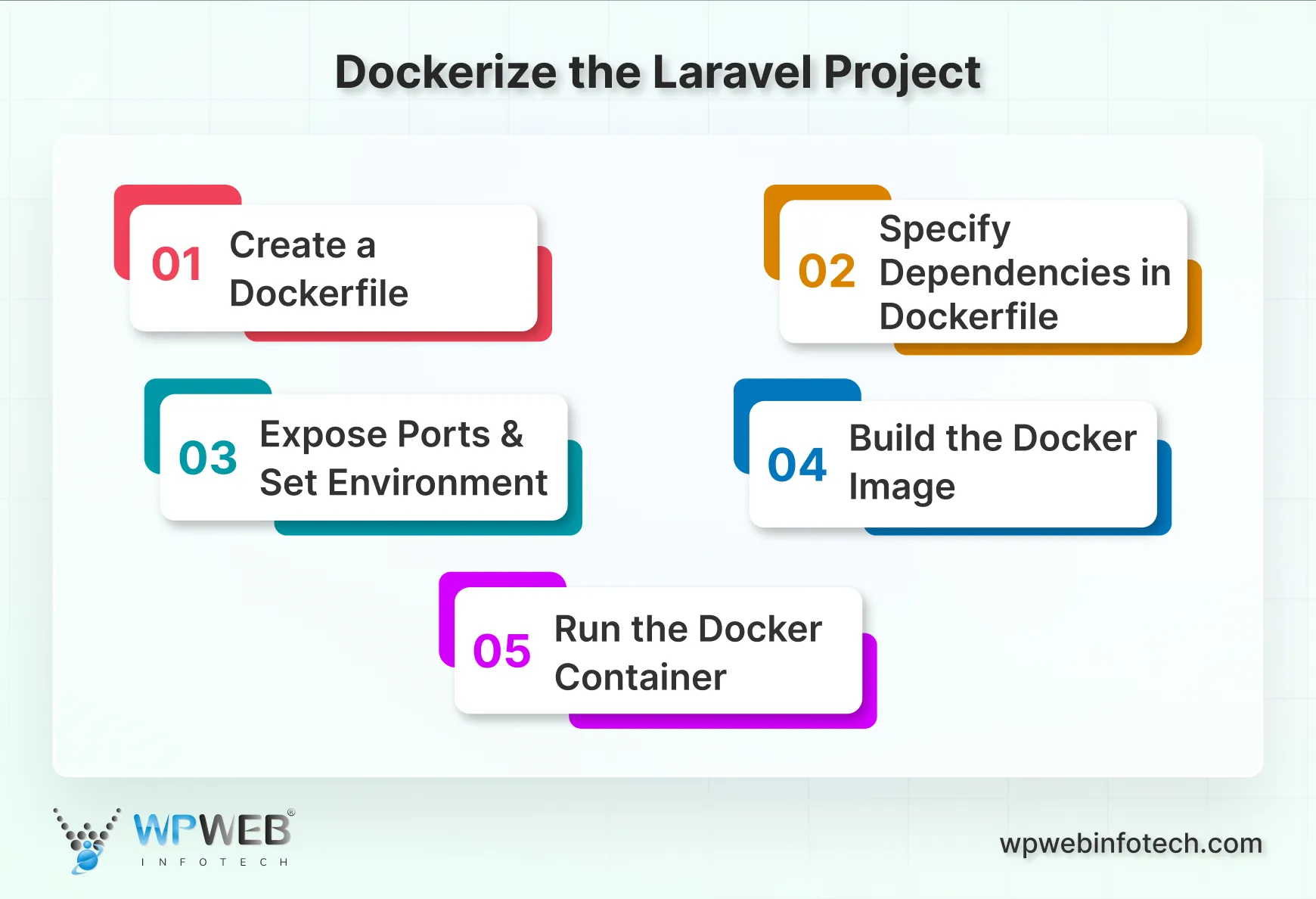
- Create a Dockerfile: In the root of your Laravel project, craft a ‘Dockerfile’. Define the base image, install PHP extensions required by Laravel, set the working directory, and copy application files. This file serves as the blueprint for building the Docker image.
- Specify Dependencies in Dockerfile: Leverage the ‘RUN’ command in the Dockerfile to install Composer and run ‘composer install’ to fetch Laravel’s PHP dependencies. This ensures that the Docker image encapsulates all required packages for the Laravel application.
- Expose Ports and Set Environment: Use the EXPOSE command to specify the port (typically 8000) on which Laravel runs. Additionally, set the ‘APP_ENV’ environment variable to ‘local’ to ensure Laravel operates in the development environment within the Docker container.
- Build the Docker Image: In the terminal, execute ‘docker build -t your-image-name’. to build the Docker image based on the configured Dockerfile. This image encapsulates your Laravel application and its dependencies in a portable and reproducible manner.
- Run the Docker Container: Start a Docker container using the built image with the command ‘docker run -p 8000:8000 -d your-image-name’. This maps the host machine’s port 8000 to the container’s port 8000, allowing you to access the Laravel application at ‘http://localhost:8000’.
By dockerizing your Laravel project, you’ve containerized the application, paving the way for enhanced consistency and portability. The Docker container encapsulates the Laravel environment, offering a reliable and secure platform for development and future deployment scenarios.
4. Configure Docker Compose
Docker Compose enables the orchestration of multiple containers, defining the services and dependencies needed for your Laravel application. This step ensures a cohesive environment for development and simplifies the management of interconnected services.
- Create a Docker Compose File: Develop a ‘docker-compose.yml’ file in the root of your Laravel project. This file serves as the configuration blueprint for Docker Compose, defining the services, networks, and volumes necessary for your Laravel application and its dependencies.
- Define Laravel Service: Within the ‘docker-compose.yml’ file, specify the Laravel service. Define the build context, Dockerfile location, and dependencies such as the database service. This ensures Docker Compose can build and run the Laravel application seamlessly.
- Include Database Service: If your Laravel application uses a database, include a database service in the ‘docker-compose.yml’ file. Specify the database image, and set environment variables like database name, user, and password, ensuring synchronization between the Laravel application and the database container.
- Configure Ports and Volumes: Define port mappings to expose the Laravel application externally, making it accessible on the host machine. Configure volumes to ensure persistent storage for important data, like the database, even when containers are stopped or removed.
- Set Environment Variables: Utilize the ‘environment’ section in Docker Compose to set environment variables required by the Laravel application. This includes variables like ‘APP_KEY’ and any other configuration options needed for your specific Laravel project.
With Docker Compose configured, your Laravel application gains a comprehensive orchestration layer. This simplifies the management of interconnected services, ensuring a harmonized development environment. As you proceed with Docker Compose, the collaboration between Laravel and Docker reaches new heights, offering a robust foundation for your web application development.
5. Build and Run the Docker Containers
The final stride involves building and running the Docker containers. This process ensures that your Laravel application and its associated services operate seamlessly within isolated containers, providing a consistent and portable development environment.
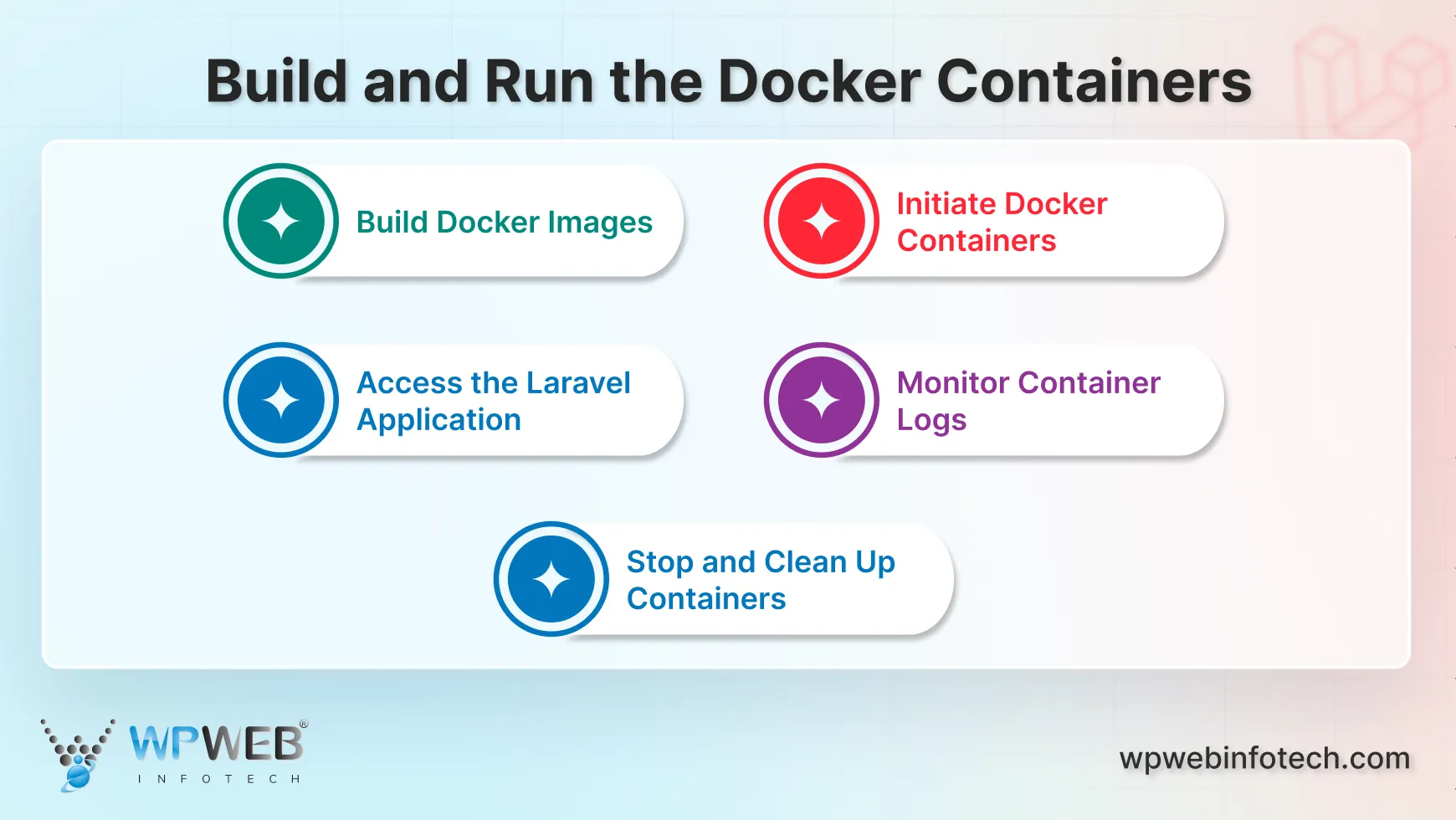
- Build Docker Images: Execute the command ‘docker-compose build’ in the terminal. This command instructs Docker Compose to build the images specified in the ‘docker-compose.yml’ file. This includes the Laravel application image and any other services defined, ensuring they are prepared for execution.
- Initiate Docker Containers: Once the images are built, start the Docker containers by running ‘docker-compose up -d’. The ‘-d’ flag detaches the containers, allowing them to run in the background. This command directs the Laravel application, database, and any other services defined in the Docker Compose configuration.
- Access the Laravel Application: Open your web browser and navigate to ‘http://localhost:8000’. The Laravel application should be accessible, indicating a successful deployment. Docker’s containerization ensures that your Laravel project runs constantly, irrespective of the underlying host environment.
- Monitor Container Logs: Use the ‘docker-compose logs’ command to monitor the logs generated by the running containers. This helps troubleshoot any issues and provides insights into the interactions between different services within the Dockerized environment.
- Stop and Clean Up Containers: To stop the Docker containers, execute ‘docker-compose down’. This command halts the running containers and removes the associated resources. For a clean slate, use ‘docker-compose down -v’ to also delete volumes, ensuring a fresh start for subsequent development or testing.
With Docker containers up and running, your Laravel application enjoys the benefits of a modular, scalable, and portable environment. The harmonious interplay between Laravel and Docker culminates in a streamlined development process, setting the stage for efficient collaboration and deployment.
How to Use Laravel and Docker Mutually in Development?
Using Laravel and Docker in development combines the strengths of a robust PHP framework with the efficiency of containerization. This integration streamlines the development process, fostering consistency, scalability, and collaboration among developers. If you are still new to such advanced terms – you can also consider getting assistance from Laravel experts. Moving on, here’s a guide on effectively utilizing Laravel and Docker to enhance your development workflows.
1. Version Control Integration
Integrating version control systems is a fundamental aspect of using Laravel and Docker in development. By synchronizing your Laravel project with Git and optimizing Docker-related files, you establish a foundation for efficient collaboration and a seamless development process.
- Git Configuration: Initialize your Laravel project as a Git repository with ‘git init’. Create a ‘.gitignore file’ to exclude Docker-related files (e.g., ‘docker-compose.yml’, ‘Dockerfile’) and vendor dependencies from version control. This ensures a clean repository without unnecessary files.
- .gitignore for Laravel: Tailor your ‘.gitignore’ file to Laravel specifics, excluding directories like ‘vendor/’, ‘node_modules/’, and sensitive files such as ‘.env’. This prevents versioning unnecessary artifacts and sensitive configuration, maintaining a concise and secure repository.
- Commit Docker Configuration: Commit essential Docker configuration files, such as the ‘Dockerfile’ and ‘docker-compose.yml’, to version control. This allows team members to replicate the Docker environment easily and ensures consistency across development environments.
- Use Branches Effectively: Leverage Git branches for different features or bug fixes. When incorporating Docker changes, create dedicated branches, ensuring a structured and traceable history. Regularly merge changes from the main branch to stay updated with Laravel and Docker advancements.
- Collaborate with Pull Requests: Foster collaboration by employing pull requests. This enables team members to review Docker-related changes before merging, maintaining code quality, and ensuring alignment with best practices. Continuous collaboration enhances the overall development experience.
Version control integration sets the stage for a well-managed Laravel and Docker development environment. By aligning your Git repository with best practices, you not only streamline collaboration but also ensure consistency and security throughout the development lifecycle.
2. Interactive Development with Containers
Embracing interactive development with containers is a pivotal strategy when utilizing Laravel and Docker in your development workflow. This approach facilitates live code changes, immediate feedback, and a dynamic development environment, enhancing efficiency and responsiveness during the development process.

- Mount Laravel Project as Volume: Utilize Docker volumes to mount your entire Laravel project into the container. This establishes a live connection, allowing changes in your local code to reflect immediately within the running container. This eliminates the need for constant container rebuilds during development.
- Leverage Docker’s Interactive Mode: Engage Docker’s interactive mode (via ‘docker run -it’) for a dynamic development experience. This mode enables direct interaction with the container’s terminal, facilitating tasks like running artisan commands, debugging, and observing real-time changes.
- Optimize Development Containers: Create dedicated Docker Compose configurations for development that include additional tools and services, such as Xdebug for PHP debugging. This ensures an optimized environment specifically tailored for interactive development needs.
- Implement Hot Reloading: Integrate tools like Laravel Mix for frontend development with hot reloading. By configuring Docker to expose the necessary ports and enable hot reloading, changes made to frontend assets are immediately reflected in the browser, providing a seamless development experience.
- Continuous Monitoring and Logging: Implement tools for continuous monitoring and logging within Docker containers. Tools like Tinker can be invaluable for inspecting variables and making quick changes during interactive development. Monitor logs to swiftly identify and address issues.
Interactive development with Docker containers injects dynamism into your Laravel projects. By embracing live code changes, utilizing Docker’s interactive mode, and optimizing the development environment, you enhance productivity and responsiveness, fostering a more enjoyable and efficient development journey.
3. Database Management
Efficient database management is a cornerstone when using Laravel and Docker in development. Docker simplifies the setup and maintenance of databases, enhancing collaboration and consistency.
- Define Database Service in Docker Compose: Within your ‘docker-compose.yml’ file, clearly specify the database service parameters such as image, environment variables (e.g., database name, user, password), and ports. This ensures seamless communication between the Laravel application and the database container.
- Utilize Persistent Volumes for Data Storage: Leverage Docker volumes to ensure persistent storage for database data. By configuring volumes in Docker Compose, you guarantee that database information persists even if the database container is stopped or removed. This is crucial for preserving data integrity during development.
- Seeding and Migrations with Artisan Commands: Integrate Laravel Artisan commands for seeding and migrations into your Docker development workflow. This allows for efficient database population and schema changes. Execute commands like ‘php artisan migrate’ and ‘php artisan db:seed’ directly within the Docker container to maintain a streamlined process.
- Database Backups and Restore Procedures: Implement backup and restore procedures for your Dockerized database. Docker provides tools like ‘docker exec’ to run commands directly inside a container. Create scripts or utilize Docker exec commands to initiate database backups, ensuring data safety and facilitating quick recovery during development.
- Interactive Database Management Tools: Explore interactive database management tools compatible with Docker. Tools like Adminer or PhpMyAdmin can be included in your Docker Compose configuration, offering a web-based interface for simplified database management. This enhances visibility and control over database activities during development.
Effectively managing databases within a Dockerized Laravel environment is essential for a smooth development journey. By adhering to these practices, you ensure data consistency, integrity, and accessibility throughout the development lifecycle. The seamless integration of Laravel and Docker extends beyond application code, encompassing the critical aspect of database management.
4. Automated Testing with Docker
Automated testing is a pivotal component in the development lifecycle, and Docker provides an ideal environment for executing tests consistently. Integrating Docker into your automated testing workflows enhances reliability, reproducibility, and efficiency.
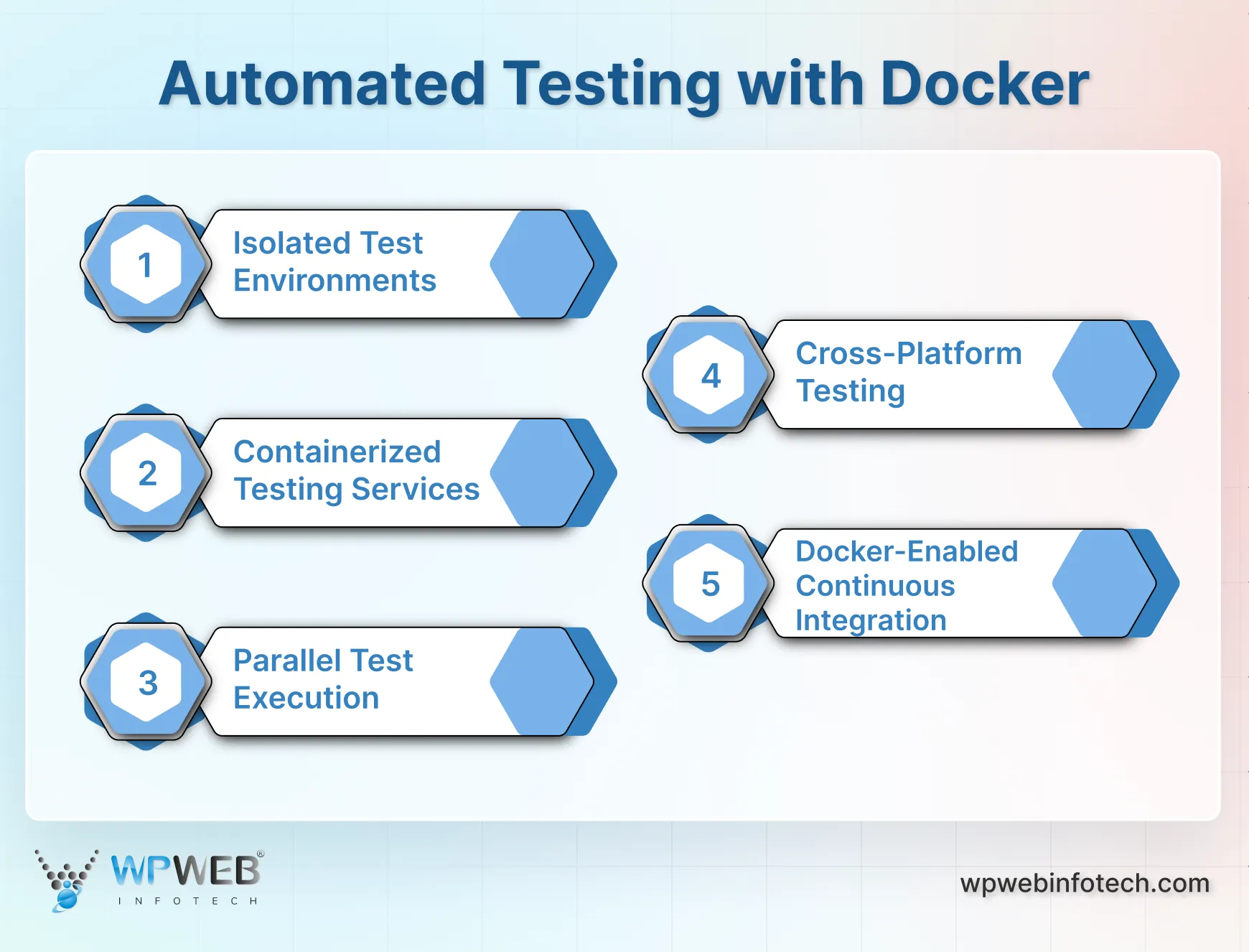
- Isolated Test Environments: Docker ensures the creation of isolated environments for running tests, minimizing interference between the testing process and the host machine. Each test suite can run within a dedicated container, guaranteeing a clean and reproducible state for every test execution.
- Containerized Testing Services: Utilize Docker Compose to define testing services such as databases, caching systems, or other dependencies. By encapsulating these services in containers, you create an environment where tests consistently interact with the same set of dependencies, fostering reliability and predictability.
- Parallel Test Execution: Leverage Docker’s scalability for parallel test execution. Docker allows you to run multiple test suites concurrently by orchestrating multiple containers. This significantly reduces the time required for test execution, contributing to a faster feedback loop during development.
- Docker-Enabled Continuous Integration: Integrate Docker into your CI/CD pipeline for seamless automated testing. Docker images can be used to create a consistent testing environment across different stages of the pipeline. This ensures that tests run in an environment similar to the production setup, catching potential issues early in the development process.
- Cross-Platform Testing: Docker facilitates cross-platform testing by encapsulating tests within containers. Developers can run tests on their local machines using the same Dockerized environment as the CI/CD pipeline. This ensures that tests are executed consistently across various platforms, reducing the likelihood of platform-specific issues.
The integration of Docker into testing workflows ensures consistent and reproducible results, contributing to a robust development environment. Consider leveraging Docker for automated testing as part of your development strategy. Additionally, for comprehensive quality assurance, it’ll be better to hire QA testers. They specialize in testing Dockerized environments can further optimize your testing processes.
5. Container Orchestration for Microservices
Container orchestration is instrumental when developing microservices, and Docker provides powerful tools for efficiently managing and scaling these services. This section explores how container orchestration, particularly in a microservices architecture, can be seamlessly implemented with Docker in Laravel development.
- Docker Compose for Service Definition: Utilize Docker Compose to define microservices and their dependencies. With a clear ‘docker-compose.yml’ file, you can orchestrate the deployment of multiple interconnected services. This simplifies the configuration and ensures a consistent and reproducible environment for each microservice.
- Scalability with Docker Swarm or Kubernetes: Leverage Docker Swarm or Kubernetes for scalable microservices orchestration. These orchestration tools enable dynamic scaling of services based on demand. Docker Swarm is built directly into Docker, offering a straightforward solution, while Kubernetes provides advanced features for large-scale deployments.
- Service Discovery and Load Balancing: Docker orchestrators facilitate service discovery and load balancing, crucial for microservices. Whether using built-in solutions like Docker Swarm’s overlay network or external tools like Consul, Docker’s orchestration capabilities ensure seamless communication between microservices and efficient distribution of traffic.
- Fault Tolerance and High Availability: Enhance the reliability of microservices by leveraging Docker orchestration for fault tolerance and high availability. Tools like Kubernetes provide features such as auto-healing and rolling updates, ensuring continuous service availability. This is particularly valuable in dynamic microservices environments.
- Centralized Logging and Monitoring: Docker orchestration platforms offer centralized logging and monitoring solutions. Utilize tools like ELK Stack (Elasticsearch, Logstash, Kibana) or Prometheus and Grafana to gain insights into the performance and behavior of microservices. This centralized approach simplifies troubleshooting and enhances overall observability.
Container orchestration is paramount in managing the complexity of microservices, and Docker provides a robust solution for Laravel development. By embracing Docker Compose, Docker Swarm, or Kubernetes, developers can efficiently manage, scale, and ensure the reliability of microservices.
How to Use Laravel and Docker in Production?
Transitioning a Laravel application from development to production requires a focus on efficiency, scalability, and reliability. For a cloud-native and scalable deployment environment, developers often deploy Laravel AWS Elastic Beanstalk, leveraging AWS infrastructure to streamline application management and performance.
Integrating Docker into the production environment adds a layer of flexibility and consistency. This guide outlines key strategies to effectively deploy Laravel with Docker in a production setting, ensuring a seamless and optimized operation.
1. Optimize Docker Images for Production
It is crucial to ensure efficient deployment and enhance the performance of a Laravel application. Streamlining the images reduces their size, accelerates deployment, and contributes to a more secure and manageable production environment.
- Minimize Image Layers: Reduce the number of layers in your Docker image by consolidating commands. This minimizes the image size and accelerates both image building and deployment. Utilize multi-stage builds to separate build-time dependencies from the final runtime image.
- Remove Unnecessary Dependencies: Carefully curate the dependencies included in the production image. Remove any packages or tools that are only necessary during development or build processes. This optimization not only reduces the image size but also mitigates potential security risks.
- Utilize Alpine Linux or Slim Base Images: Choose lightweight base images like Alpine Linux or Slim variants. These minimalistic images provide a smaller attack surface and reduce the overall image size. Alpine Linux, in particular, is renowned for its small footprint and security features.
- Cache Dependencies Separately: Leverage Docker layer caching to optimize the build process. Cache dependencies separately, ensuring that unchanged dependencies are reused during subsequent builds. This approach minimizes the time required for building images and speeds up the deployment process.
- Implement Multi-Stage Builds: Embrace multi-stage builds to create a lean production image. Use separate stages for building and packaging dependencies, and then copy only essential artifacts to the final image. This not only results in a smaller image but also eliminates unnecessary build artifacts.
Optimizing Docker images for production is pivotal for achieving a streamlined and efficient deployment process. These practices contribute to a robust foundation for the deployment of Dockerized Laravel applications.
2. Secure Environment Variables
In a production environment, ensuring the security of sensitive information, such as database credentials and API keys, is paramount. This guide explores best practices for securing environment variables in Dockerized Laravel applications, mitigating potential security risks, and maintaining the confidentiality of critical data.
- Docker Secrets for Enhanced Security: Docker provides a native solution called Docker Secrets, offering a secure way to manage sensitive information within Docker Swarm clusters. Secrets are encrypted both at rest and in transit, adding an extra layer of protection for critical data like database passwords.
- Externalized Environment Files: Store environment variables, including sensitive ones, in externalized files like ‘.env’. Docker Compose allows referencing these files during container creation, minimizing the exposure of sensitive data within the Docker image. This practice enhances security by separating configuration from the application code.
- Dynamic Injection of Secrets: Avoid hardcoding sensitive information directly in Dockerfiles or application code. Instead, dynamically inject secrets at runtime through environment variables. This ensures flexibility in managing sensitive data, allowing changes without modifying the Docker image or application source code.
- Integration with External Key Management Systems: For advanced security requirements, integrate external key management systems like HashiCorp Vault. These systems provide centralized management and rotation of secrets, enabling sophisticated access controls and encryption mechanisms. Integrating such solutions enhances the overall security posture.
- Encryption of Sensitive Files: Encrypt files containing sensitive information before storage or sharing, especially when using version control systems. Tools like Ansible Vault or Git-crypt can encrypt files, adding an extra layer of security. Managing decryption keys securely is crucial to maintaining accessibility while protecting against unauthorized access.
Securing environment variables in a Dockerized Laravel application is fundamental to maintaining the confidentiality and integrity of sensitive data in a production environment. By embracing Docker Secrets, externalizing environment files, dynamically injecting secrets, and integrating you establish a robust defense against potential security vulnerabilities.
3. Implement Container Orchestration
Container orchestration is pivotal for managing the complexities of deploying and scaling applications, particularly in a production environment. Implementing container orchestration for Dockerized Laravel applications ensures seamless coordination, scalability, and reliability, contributing to a well-orchestrated production environment.
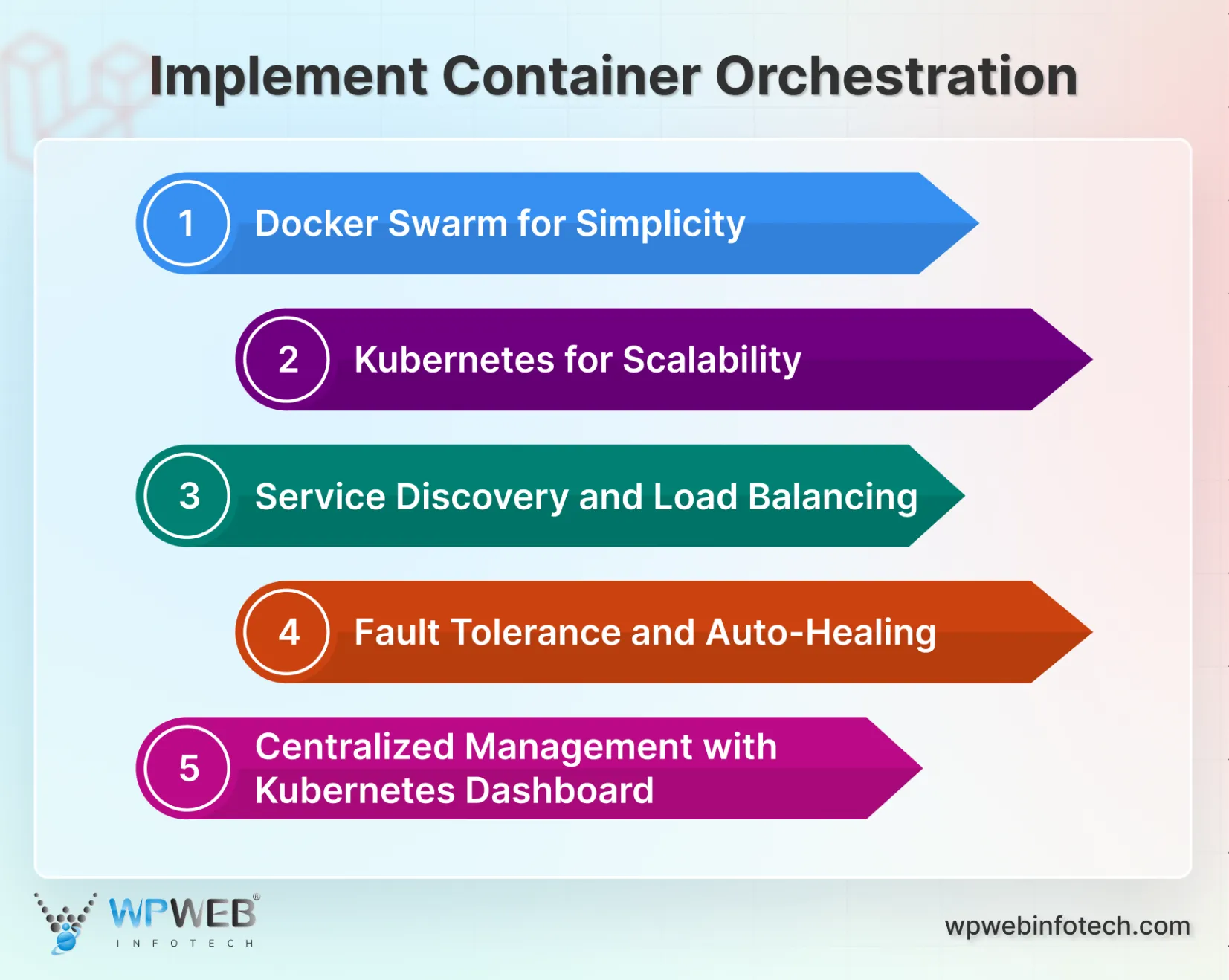
- Docker Swarm for Simplicity: Docker Swarm provides built-in container orchestration functionality within the Docker ecosystem. It is a straightforward choice for smaller-scale deployments due to its simplicity and seamless integration with Docker. Docker Swarm enables easy scaling, load balancing, and service discovery for Laravel applications.
- Kubernetes for Scalability: Kubernetes, a robust and widely adopted container orchestration platform, excels in handling large-scale deployments. It offers advanced features for automated scaling, rolling updates, and intricate networking setups. Kubernetes is suitable for complex Laravel applications with high scalability requirements in production environments. Similarly, Laravel Vapor enables serverless deployment of Laravel apps, providing automatic scaling and simplified cloud management.
- Service Discovery and Load Balancing: Container orchestration platforms excel in service discovery and load balancing, crucial for distributing traffic effectively. Whether utilizing Docker Swarm or Kubernetes, these platforms automate the management of network traffic, ensuring that requests are evenly distributed among containerized Laravel services for optimal performance.
- Fault Tolerance and Auto-Healing: Container orchestration platforms enhance the fault tolerance of Dockerized Laravel applications. Kubernetes, for example, offers automated self-healing capabilities. In case of container failures, the orchestration platform detects issues and automatically replaces or reschedules containers, minimizing downtime and ensuring continuous service availability.
- Centralized Management with Kubernetes Dashboard: Kubernetes provides a user-friendly web-based dashboard for centralized management of containerized applications. This graphical interface allows operators to monitor, troubleshoot, and manage various aspects of the deployment, streamlining administrative tasks and providing insights into the health of Laravel services.
Implementing container orchestration is fundamental for orchestrating the deployment, scaling, and management of Dockerized Laravel applications in production. Whether opting for Docker Swarm’s simplicity or Kubernetes’ scalability, these orchestration platforms automate critical tasks, enhance fault tolerance, and provide centralized management capabilities.
4. Use Persistent Storage for Data
Ensuring persistent storage for data in a Dockerized Laravel application is crucial for maintaining data integrity, especially in production. By implementing robust storage solutions, you guarantee that essential data persists across container restarts, contributing to a reliable and resilient production environment.
- Leverage Docker Volumes: Docker volumes provide a native and efficient solution for persistent storage. Utilize volumes to store critical data, such as database files or application uploads, separately from the container filesystem. This ensures that data persists even if the container is stopped, removed, or replaced.
- External Storage Solutions: Integrate external storage solutions for more scalable and durable data persistence. Services like Amazon S3 and Google Cloud Storage can be used to store large volumes of data externally. Laravel applications can seamlessly interact with these external storage services.
- Consider Database Backups: Implement regular database backups as part of your data persistence strategy. Dockerized Laravel applications benefit from tools like ‘mysqldump’ or database-specific backup solutions. Schedule backups and store them in persistent storage, allowing for easy recovery in case of data loss or system failures.
- Separate Storage for Logs and Sessions: Dedicate specific storage locations for logs and session data. By storing logs and session files outside the container filesystem, you ensure that crucial information persists across container instances. Docker volumes or external storage solutions can be employed for these purposes.
- Ensure Data Replication for High Availability: In scenarios requiring high availability, implement data replication strategies. For databases, consider setting up master-slave replication or clustering. This ensures that multiple instances of the Laravel application can access and update data concurrently, enhancing both availability and reliability.
Utilizing persistent storage for data in a Dockerized Laravel application is pivotal for building a resilient and reliable production environment. Whether leveraging Docker volumes, external storage solutions, or implementing backups, these practices contribute to data persistence and integrity, ensuring a robust foundation for Dockerized Laravel applications in production.
5. Set Up Continuous Integration/Continuous Deployment (CI/CD)
Implementing Continuous Integration and Continuous Deployment (CI/CD) for Dockerized Laravel applications is pivotal for automating the software development lifecycle. This guide explores key practices to establish an efficient CI/CD pipeline, enhancing deployment speed, reducing errors, and ensuring a seamless release process in a production environment.
- Docker Image Automation: Integrate Docker into your CI/CD pipeline to automate the creation of Docker images. Use tools like Docker Compose to define build and test environments, ensuring consistency between development and production. This automation reduces the risk of discrepancies between different stages of the deployment process.
- Automated Testing for Dockerized Laravel: Implement automated testing within your CI/CD pipeline to validate the functionality and integrity of your Dockerized Laravel application. Utilize PHPUnit for Laravel testing and Docker-specific testing tools to ensure that changes introduced during the development process do not compromise the application’s stability.
- Containerized Deployment Process: Containerize the deployment process by incorporating Docker images into your CI/CD pipeline. Automate the deployment of Docker containers to your production environment, ensuring that the entire application, including dependencies, is consistently replicated from the CI/CD pipeline to production.
- Rolling Updates and Rollbacks: Execute rolling updates for Dockerized Laravel applications during the deployment process. This allows updates to be gradually applied, minimizing downtime and ensuring continuous availability. Additionally, establish mechanisms for rollbacks in case issues are identified post-deployment, providing a safety net for the production environment.
- Monitoring and Alerting in CI/CD: Integrate monitoring and alerting tools into your CI/CD pipeline to proactively detect issues. Tools like Prometheus or Jenkins can be used to monitor the health and performance of Docker containers during the deployment process. Incorporate alerts to notify teams of any anomalies, enabling rapid response and issue resolution.
Establishing a robust CI/CD pipeline for Dockerized Laravel applications is essential for achieving efficiency, reliability, and agility in the deployment process. These practices contribute to a faster and more reliable release cycle for Dockerized Laravel applications.
Let’s Conclude
The dynamic duo of Laravel and Docker offers a powerful synergy that significantly simplifies the complexities of web development. Setting up Laravel with Docker, from local development to production deployment, streamlines tasks, enhances collaboration, and ensures a more efficient workflow.
Docker’s ability to encapsulate the Laravel application and its dependencies simplifies both development and production environments, fostering a consistent and reliable ecosystem.
Eager to reshape your development journey with Laravel and Docker? Then request a personalized 1:1 consultation with our Laravel developers on hire and step on a journey to simplify your development processes.
FAQs About Laravel and Docker
Is there any additional cost for using Laravel and Docker?
No, both Laravel and Docker are open-source and free to use. However, additional costs may arise from:
– Hosting services (e.g., AWS, DigitalOcean, etc.) if you deploy Docker containers to production.
– Premium Docker tools, such as Docker Hub Pro for private repositories.
– Development tools or platforms like Laravel Forge or Laravel Vapor.
– Time and expertise if your team needs to learn or manage Docker infrastructure.
How to run an existing Laravel project with Docker?
– Dockerize the Project: Create a Dockerfile for the Laravel project, specifying dependencies, configurations, and build steps required for containerization.
– Use Docker Compose:Set up a Docker Compose file to define the services needed for the Laravel application, such as the web server, database, and any additional services.
– Build and Run Containers:Execute ‘docker-compose build’ to build Docker images and ‘docker-compose up’ to start containers. This recreates the Laravel environment within Docker containers.
– Database Configuration:Adjust the Laravel project’s database configuration to match the settings in the Docker Compose file, ensuring proper communication between the Laravel application and the database container.
– Access the Application: Once containers are running, access the Laravel application through the specified ports or URLs, configured in the Docker Compose file.
Are there any alternatives to using Laravel and Docker for development?
-Traditional Hosting:Some developers may choose traditional hosting solutions without containerization, deploying Laravel applications on virtual servers or shared hosting environments.
– Vagrant and Homestead:Vagrant, along with Laravel Homestead, provides an alternative for development environments, offering pre-packaged virtual machines for Laravel projects.
– Native Development Environment:Developers may opt for a native development environment, installing PHP, a web server, and required dependencies directly on their machines without containerization.
– Cloud Development Platforms:Cloud development platforms, such as AWS Cloud9 or Google Cloud Shell, offer browser-based IDEs and development environments, providing alternatives to local setups.
– Other Containerization Technologies: While Docker is widely used, alternatives like Podman or container orchestration platforms like OpenShift may be considered based on specific project requirements and preferences.
What’s the difference between traditional Laravel deployment and Laravel Vapor?
Traditional deployment involves setting up servers, databases, and scaling configurations manually. If you want a complete step-by-step overview, need to know how to deploy Laravel App. Vapor, on the other hand, handles all these steps automatically through AWS Lambda, offering a fully serverless experience.
Unlock Laravel’s Full Potential for Your Project
Partner with experts who know how to build scalable and efficient Laravel applications.





